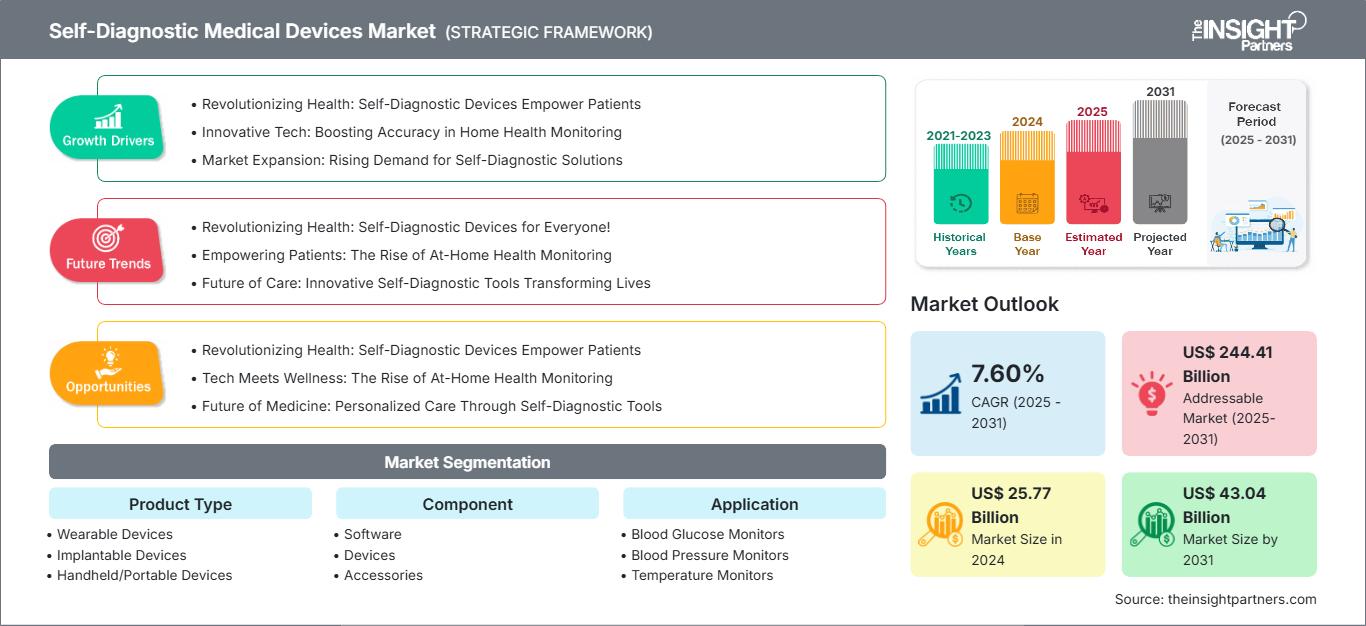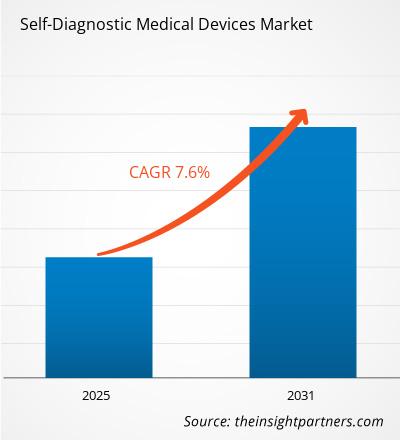自己診断医療機器市場は、2025年から2031年にかけて7.60%のCAGRで成長し、市場規模は2024年の257億7,000万米ドルから2031年には430億4,000万米ドルに拡大すると予想されています。
本レポートは、製品タイプ(ウェアラブルデバイス、埋め込み型デバイス、ハンドヘルド/ポータブルデバイス、据置型デバイス)別に分類され、コンポーネント(ソフトウェア、デバイス、アクセサリ)に基づいて市場をさらに分析しています。また、アプリケーション(血糖値モニター、血圧モニター、体温モニター、妊娠/不妊検査キット、睡眠時無呼吸デバイス)および業界エンドユーザー(在宅ケア施設、リハビリテーションセンター)別にも市場を分析しています。これらの主要セグメントごとに、世界、地域、国レベルで包括的な内訳が提供されています。
本レポートには、全セグメントの市場規模と予測が含まれており、価格は米ドルで表示されています。さらに、主要企業の現在の市場状況に関する主要な統計情報、現在の市場トレンド、新たな機会に関する洞察も提供しています。
報告書の目的
インサイト・パートナーズによる自己診断医療機器市場レポートは、現状と将来の成長、主要な推進要因、課題、そして機会を解説することを目的としています。これにより、以下のような様々なビジネスステークホルダーに洞察を提供します。
- テクノロジープロバイダー/メーカー: 進化する市場の動向を理解し、潜在的な成長機会を把握することで、情報に基づいた戦略的意思決定を行えるようにします。
- 投資家: 市場の成長率、市場の財務予測、バリュー チェーン全体に存在する機会に関する包括的な傾向分析を実施します。
- 規制機関: 市場の濫用を最小限に抑え、投資家の信用と信頼を維持し、市場の健全性と安定性を維持することを目的として、市場における政策と警察活動を規制します。
自己診断医療機器市場のセグメンテーション
製品タイプ
- ウェアラブルデバイス
- 埋め込み型デバイス
- ハンドヘルド/ポータブルデバイス
- 固定式デバイス
成分
- ソフトウェア
- デバイス
- アクセサリー
応用
- 血糖値モニター
- 血圧モニター
- 温度モニター
- 妊娠・不妊検査キット
- 睡眠時無呼吸症候群治療機器
エンドユーザー
- 在宅ケア設定
- リハビリテーションセンター
このレポートの一部、国レベルの分析、Excelデータパックなど、あらゆるレポートを無料でカスタマイズできます。また、スタートアップや大学向けのお得なオファーや割引もご利用いただけます。
自己診断医療機器市場:戦略的洞察

- このレポートの主要な市場動向を入手してください。この無料サンプルには、市場動向から見積もりや予測に至るまでのデータ分析が含まれます。
自己診断医療機器市場の成長ドライバー
- 健康革命:自己診断機器が患者に力を与える
- 革新的技術:在宅健康モニタリングの精度向上
- 市場拡大:自己診断ソリューションの需要増加
自己診断医療機器市場の将来動向
- 健康に革命を起こす:誰もが使える自己診断デバイス!
- 患者のエンパワーメント:在宅健康モニタリングの台頭
- ケアの未来:革新的な自己診断ツールが人生を変える
自己診断医療機器の市場機会
- 健康革命:自己診断機器が患者に力を与える
- テクノロジーと健康の融合:在宅健康モニタリングの台頭
- 医療の未来:自己診断ツールによる個別ケア
自己診断医療機器市場の地域別分析
予測期間全体を通して自己診断医療機器市場に影響を与える地域的な傾向と要因は、The Insight Partnersのアナリストによって徹底的に解説されています。このセクションでは、北米、ヨーロッパ、アジア太平洋、中東・アフリカ、中南米における自己診断医療機器市場のセグメントと地域についても解説します。
自己診断医療機器市場レポートの範囲
| レポート属性 | 詳細 |
|---|---|
| 2024年の市場規模 | 257億7000万米ドル |
| 2031年までの市場規模 | 430億4000万米ドル |
| 世界のCAGR(2025年~2031年) | 7.60% |
| 履歴データ | 2021-2023 |
| 予測期間 | 2025~2031年 |
| 対象セグメント | 製品タイプ別
|
| 対象地域と国 | 北米
|
| 市場リーダーと主要企業の概要 |
|
自己診断医療機器市場のプレーヤー密度:ビジネスダイナミクスへの影響を理解する
自己診断医療機器市場は、消費者の嗜好の変化、技術の進歩、製品の利点に対する認知度の高まりといった要因によるエンドユーザーの需要増加に牽引され、急速に成長しています。需要の増加に伴い、企業は製品ラインナップの拡充、消費者ニーズへの対応のためのイノベーション、そして新たなトレンドの活用を進めており、これが市場の成長をさらに加速させています。

- 自己診断医療機器市場のトップキープレーヤーの概要を入手
主なセールスポイント
- 包括的なカバレッジ:レポートでは、自己診断医療機器市場の製品、サービス、種類、エンドユーザーの分析を包括的にカバーし、全体的な展望を提供します。
- 専門家の分析:レポートは、業界の専門家とアナリストの深い理解に基づいて作成されています。
- 最新情報: このレポートは、最新の情報とデータの傾向を網羅しているため、ビジネスの関連性を保証します。
- カスタマイズ オプション: このレポートは、特定のクライアント要件に対応し、ビジネス戦略に適切に適合するようにカスタマイズできます。
したがって、自己診断医療機器市場に関する調査レポートは、業界の状況と成長見通しを解明し、理解するための先導役となるでしょう。いくつかの妥当な懸念事項はあるものの、このレポートの全体的なメリットはデメリットを上回る傾向にあります。
- 過去2年間の分析、基準年、CAGRによる予測(7年間)
- PEST分析とSWOT分析
- 市場規模価値/数量 - 世界、地域、国
- 業界と競争環境
- Excel データセット
最新レポート
お客様の声
購入理由
- 情報に基づいた意思決定
- 市場動向の理解
- 競合分析
- 顧客インサイト
- 市場予測
- リスク軽減
- 戦略計画
- 投資の正当性
- 新興市場の特定
- マーケティング戦略の強化
- 業務効率の向上
- 規制動向への対応




















 無料サンプルを入手 - 自己診断医療機器市場
無料サンプルを入手 - 自己診断医療機器市場